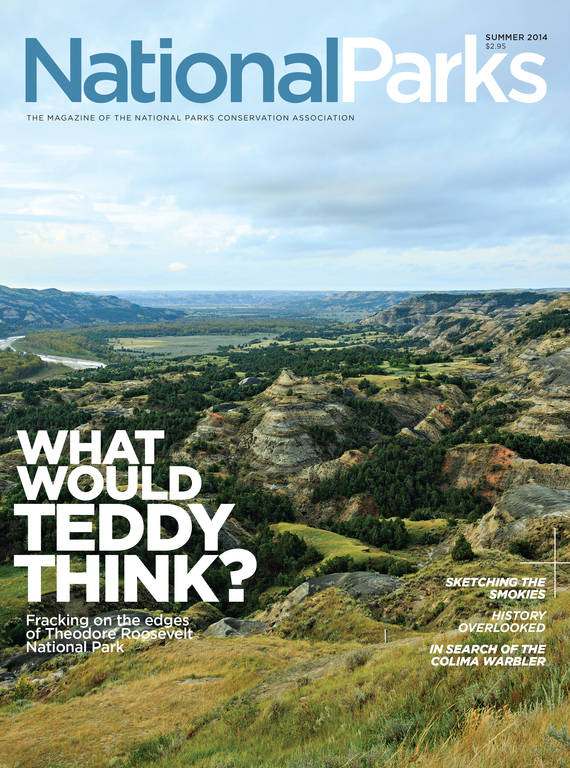Summer 2014
Flight Tracking
At Governors Island National Monument, biologists are discovering how birds navigate through New York City’s skyscrapers.
He gestures around the grounds, pointing out Castle Williams and Fort Jay, before turning to the field itself. “This was a nine-hole golf course, but they stopped using it when the Coast Guard left in 1996,” he says. “So that made it a perfect spot for the radar.”
The radar to which he refers is a MERLIN Avian Radar System, specially designed to detect clouds of songbirds. It was put there in 2012 by Alan Clark, a biology professor at Fordham University, and Susan Elbin, the director of conservation and science at New York City Audubon. Clark and Elbin were looking for a good spot to study a poorly understood but ecologically important phenomenon: the nighttime habits of birds as they migrate through one of the most congested urban corridors in the world.
BIRD’S-EYE VIEW
Every year in the spring and fall, millions of bluebirds, finches, grosbeaks, sparrows, thrushes, warblers, and the like fly up and down the Eastern Seaboard. Their journey takes place almost entirely at night; cooler air is more stable, and the darkness helps conceal them from predators. To navigate, they use the moon and stars.
For millions of years, those celestial bodies were the only lights available. But in the last couple of centuries or so, the birds’ migratory routes have undergone, to put it mildly, a remarkable transformation. Now, a large metropolis like New York City offers a songbird, as Clark says, “many ways to die.” Birds smack into building windows, their tiny, feathered bodies sometimes littering sidewalks or observation decks in the morning. Light has a special allure; when the great spotlights of the 9/11 Tribute in Light were lit, thousands of birds became trapped in the beams, helplessly circling like dust motes. “More than 90,000 birds are dying in the city each year, and that’s probably a significant underestimate,” says Elbin. Her work has shown that only one-third to one-quarter of carcasses are ever found; most are cleaned up by street sweepers or feasted upon by feral cats and rats.
When Clark began his study in 2009, he just listened for birds. Passing flocks communicate with one another using special calls to keep track of their companions and to warn of possible dangers. The flight calls, which are species specific, are so high and quiet and short as to be barely audible to humans; to the unschooled ear, they all sound the same: tseep!
Clark put microphones at six sites along a 35-mile corridor from Central Park to Scarsdale, pairing a well-lit noisy area with a dark, quiet site nearby. He expected migrating birds to prefer the quieter areas, but he found the opposite: Microphones in the lighted areas detected many times more flight calls. But it was hard to interpret precisely what that meant. Were the lights luring the birds away from green spaces that were safer? Or did a few birds simply call more in the bright environments, trying to keep tabs on one another, while the birds in the dark sites were silent?

National Parks
You can read this and other stories about history, nature, culture, art, conservation, travel, science and more in National Parks magazine. Your tax-deductible membership donation of $25 or more entitles…
See more ›Clark saw that he needed another means of monitoring migration if he was to learn how many birds there were. He and Elbin decided to use a special type of marine radar. But he also wanted a spot to put the radar where he could catch the birds just before they entered Manhattan. After canvassing, they found that the Governors Island National Monument provided the perfect vantage, sitting as it does just south of the junction of the Hudson River and East River. And so he put his 4,000-pound radar on the abandoned golf course and left it running for two weeks during the spring migration.
What he saw astounded him. The radar’s coverage area was about one square kilometer. As day faded to dusk, Clark watched as little specks of green started to dot the screen. Then, after the sun set, the green bloomed spectacularly, like a mushroom cloud of thousands of birds, all of them making for Manhattan. During peak periods, more than 15,000 passed through that small area every hour. By the time the study ended, nearly 2 million birds had migrated through that single square of sky.
In the imagined view of one of these millions—a warbler or finch that weighs only a few grams—it is hard not to blanch at the sight of the city from Governors Island, looming like a colossus across the harbor as it does. But Clark’s data showed that about half of the birds fly at altitudes below the height of a 70-story building, of which Manhattan has plenty.
For Clark, the next step is to determine how birds maneuver through the skyscape. “A bird sees the city,” he says. “What does it do? Take a left and go up the Hudson, or fly right over the East River? Fly over the buildings or between them?” Knowing the answer will help managers figure out ways to make cities more bird-friendly, as, year after year, exhausted waves of them pick their way through the maze of noise and light, pushing on to quieter spaces.



